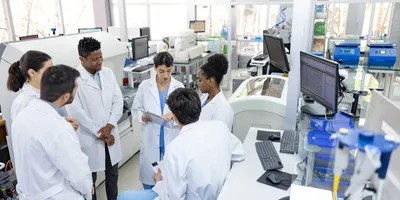How many times has a situation like this unfolded in your lab?
A team gathers to decide whether to validate a new protocol for sample processing; one that could reduce turnaround time but hasn’t yet been tested in your lab’s workflow. The meeting begins slowly. Team members glance around the room, hesitant to be the first to speak. All eyes eventually turn to a well-respected senior scientist.
Once they weigh in—voicing strong support for keeping the current method, citing past success and regulatory stability—the tone is set. No one else in the room offers a differing opinion or expresses major concerns with the current method.
Sounds like an easy decision, right? Not necessarily. Despite the lack of open disagreement, several team members actually held different opinions but hesitated to speak up. Why? It’s a classic case of groupthink, where the desire to maintain harmony or avoid challenging authority overrides critical thinking. In these moments, silence doesn’t signal agreement; it signals pressure to conform
The impact of groupthink on the lab
Groupthink can occur for the following reasons:
Deference to senior scientists or managers
In the introductory scenario, although the intent is to have an open exchange of ideas without self-censorship, this is precisely what is happening. This type of groupthink is often unintentional or automatic—team members may assume the senior person knows best. But this issue can be even more problematic if the organizational culture emphasizes rank differences.
Suppression of dissent
This behavior emerges through a chain of cause and effect. For example, a meeting is called to address a specific issue. Leadership voices their opinions early in the discussion. After that, everyone else falls into line. If they say anything, it is consistent with or advances what management said. No one wants to be the first or only person to contradict management. Over time, this dynamic reinforces a culture where disagreement feels unwelcome.
Narrow decision-making
Groupthink can limit the range of options considered, especially when conformity is valued over exploration. For example, a team member may be aware of a new methodology or product that could solve a problem facing the organization. Instead of evaluating it on its merits, others may respond with, “That’s not how we do things here,” and redirect the conversation back to familiar practices. The result: promising ideas are dismissed prematurely, and decision-making stays confined to what’s already known and comfortable.
Overconfidence in group decisions
When conformity is prioritized, teams may skip a thorough evaluation of the issue at hand. Instead of analyzing the strengths, weaknesses, risks, and alternatives, they quickly accept the proposed idea as the best option, simply because it aligns with the group consensus. This unchecked confidence can lead to flawed decisions and negative operational consequences, such as:
Reduced scientific rigor: Team members may accept expected outcomes without critical review, undermining the scientific method and increasing the risk of flawed conclusions.
Missed opportunities: Fear of challenging the status quo can cause the lab to overlook new methods, tools, or markets—giving competitors the chance to advance while the lab stagnates.
Stalled progress: Resistance to change limits innovation, resulting in reduced effectiveness and efficiency compared to more adaptive organizations.
Lower morale and engagement: When contributions are consistently dismissed, employees disengage, leading to higher turnover, increased hiring and training costs, and lost productivity.
Groupthink is causing people to work at a sub-optimal level. They withhold valuable input due to rejection from above or within their group. As a result, the organization is vulnerable to weaknesses and threats that could be countered by members’ strengths and capitalizing on missed opportunities.
Advanced Lab Management Certificate
The Advanced Lab Management certificate is more than training—it’s a professional advantage.
Gain critical skills and IACET-approved CEUs that make a measurable difference.
How lab managers can prevent groupthink
Lab managers play a critical role in shaping team culture and that includes actively guarding against groupthink. Start by recognizing your team as your sphere of influence. The way you lead meetings, solicit input, and respond to dissent sets the tone for whether diverse viewpoints are welcomed or suppressed.
Use team meetings as opportunities to model and encourage critical thinking. Don’t just present updates; rather, invite thoughtful challenges. Pose open-ended questions, ask for alternative interpretations of data, and emphasize that disagreement is not only acceptable but valuable. One effective tactic is to rotate meeting facilitators among team members. This shift in dynamics gives others a chance to lead and can disrupt any perceived hierarchy that silences voices.
Assign a “devil’s advocate” in every meeting—a rotating role tasked with questioning assumptions and presenting counterarguments. This normalizes dissent and reduces the stigma of speaking against the majority view. Additionally, provide anonymous feedback options, such as digital suggestion boxes or post-meeting surveys. These allow quieter team members to share insights they might hesitate to voice publicly.
Most importantly, build psychological safety. Foster an environment where every team member knows their input is respected, even if it’s not acted on. Acknowledge contributions openly and thank those who offer differing perspectives. Over time, this culture of openness not only prevents groupthink, but it also strengthens your lab’s decision-making, innovation, and resilience.
The payoff? A more adaptive, engaged, and forward-thinking team—one that’s equipped to tackle complex problems with rigor and creativity.












